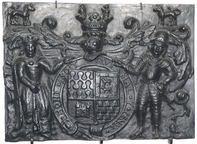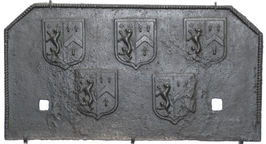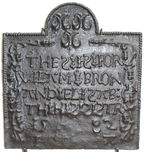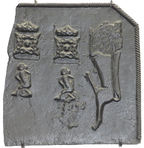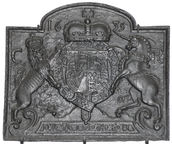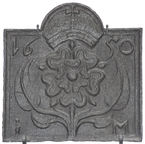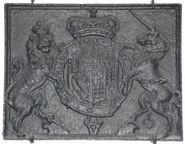-
740
Description: Plain rectangular plate; shield, garter, helm, mantling and supporters of the Blount family, Lords Mountjoy.
Notes: The arms are those of Charles Blount, 8th Baron Mountjoy, who was invested Knight of the Garter in 1597. He was created 1st Earl of Devonshire in 1603. Blazon: 1. (Blount) Barry nebuly of six Or and Sable; 2. (Ayala) Argent, two wolves passant Sable on a bordure of the first eight saltires Gules; 3. (Mountjoy) Or a tower Azure; 4. (Gresley) Vair. An unusually bold and detailed casting; the buckle missing from the garter suggests that this plate has been cropped from a larger fireback.
Inscription: HONI·SOIT·QVI·MAL·Y·PENSE
Arms: Charles Blount, KG, 8th Baron Mountjoy
- Decoration tags:
- rectangular (shape)
- none (edging)
- whole carved pattern
- armorial
- text
Manufactured: in the late-16th to early-17th century in England.
Current location: Victoria & Albert Museum, Cromwell Road, Kensington & Chelsea, Greater London, England.
Museum number: 323.1907 (part of the Victoria & Albert Museum museum group)
- Attached to series:
- Personal armorial firebacks
- Mountjoy series
-
741
Description: Rectangular, with canted top corners; twisted rope edging (top and sides only); five shields of Ayloffe impaling Sulyard in two rows, 3-2; Ayloffe: sable, a lion rampant Or, collared gules, between three crosses formy of the second; Sulyard: argent, a chevron gules between three pheons inverted sable. Two cut notches probably for firedogs.
Notes: William Ayloffe (c1535-1584) of Bretons, Hornchurch, Essex, Justice of the Court of Queen’s Bench, married (c1560) Jane, dau. of Sir Eustace Sulyard, of Runwell, Essex. A large number of variants use the same shields. The excrescences affecting the left and right sides respectively of the lower shields are the result of inexpert ladling of the iron during casting. Part of the bequest to the Victoria and Albert Museum by Lieut. Colonel G. B. Croft-Lyons in 1926.
Arms: Ayloffe impaling Sulyard (William Ayloffe of Bretons, Hornchurch)
- Decoration tags:
- rectangular with canted top corners (shape)
- rope (edging)
- carved stamps
- armorial
Manufactured: in the early-17th century in the Weald area of England.
Current location: Victoria & Albert Museum, Cromwell Road, Kensington & Chelsea, Greater London, England.
Museum number: M.621-1926 (part of the Victoria & Albert Museum museum group)
- Attached to series:
- Ayloffe series
- Personal armorial firebacks
- Andiron slot firebacks
-
742
Description: Rectangular with canted top corners; twisted rope edging all round except base: plain plate with two stamps of an iron firedog with twisted neck and shield bearing letters HN and crossed staples; firedogs have columnar capitals; fleur de lys stamp repeated six times, singly at each end, in star pattern in middle; stamps have twisted wreaths.
Notes: The initials HN probably refer to Henry Nevill, the crossed staples being a badge of the Nevill family. Henry Nevill occupied Mayfield furnace from about 1585 until 1599. One of two variants (see no. 393) with the same firedogs and fleurs-de-lys; other firedogs in a very similar style are known.
Inscription: HN HN
- Decoration tags:
- rectangular with canted top corners (shape)
- rope (edging)
- simple stamps
- carved stamps
- heraldic
- text
- objects
Manufactured: in the late-16th century possibly at Mayfield Furnace in the Weald area of England.
Current location: Victoria & Albert Museum, Cromwell Road, Kensington & Chelsea, Greater London, England.
Museum number: 11.1900 (part of the Victoria & Albert Museum museum group)
-
743
Description: Arched rectangular shape; ovolo moulded edging; Tudor royal shield, garter, crown, motto and supporters (crowned lion and dragon), temp. Elizabeth I; the top of the lion's crown and the dragon's ear overlap the edging.
Notes: Another version has a rose and portcullis either side of the crown, and the top of the lion's crown and the dragon's ear do not overlap the edging; a faint blank rectangular stamp on each side of the crown may have been to hide initials, which have been noted on a variant of this fireback.
Copies of this fireback are known.
Inscription: [Garter] HONI SOIT QVI MAL E PENSE / [motto] DIEV ET MON DROIT
Arms: Tudor royal
- Decoration tags:
- rectangular with round arch (shape)
- ovolo (edging)
- whole carved pattern
- planklines
- armorial
- royal
- text
Manufactured: in the mid- to late-16th century possibly in the Weald area of England.
Current location: Victoria & Albert Museum, Cromwell Road, Kensington & Chelsea, Greater London, England.
Museum number: 794.1896 (part of the Victoria & Albert Museum museum group)
- Attached to series:
- Tudor royal armorial firebacks
- Tudor royal armorial (plain) series
-
744
Description: Arched rectangular shape; twisted rope edging (top and sides only); three water bougets (leather water containers) at top; knotted cord and tassel decoration on each side; centred inscription on six lines with ‘S’ reversed, bar across top of ‘A’ and letters individually placed and separated by small, opposed fleurs-de-lys.
Notes: The approximately mirrored cord decoration appears to have been affixed to shaped boards. The Wealden origin of this fireback suggests possible connections with the Roos, or de Ros, family, who owned property in Easebourne, or the Meeres family of Glynleigh, near Hailsham, the arms of both families incorporating water bougets. A connection, previously proposed by the Victoria and Albert Museum, with the Ross family of Helmsley, Yorkshire, is improbable. One of a small series of distinctive firebacks cast in 1582, most with inscriptions dedicated to pairs of individuals; the initials IA may be of the founder as they appear in the same arrangement on other firebacks. Part of the bequest to the Victoria and Albert Museum by Lieut. Colonel G. B. Croft-Lyons in 1926.
Inscription: THES:IS:FOR / WILAM:BRON / AND:ELISAB: / TH:HIS:SISTR / 15 82 / I A
- Decoration tags:
- rectangular with round arch (shape)
- rope (edging)
- simple stamps
- carved stamps
- individual letters
- individual numbers
- heraldic
- text
- objects
Manufactured: in 1582 possibly at Pounsley Furnace, Framfield in the Weald area of England.
Current location: Victoria & Albert Museum, Cromwell Road, Kensington & Chelsea, Greater London, England.
Museum number: M.977-1926 (part of the Victoria & Albert Museum museum group)
- Attached to series:
- Pounsley series
- 1582 IA series
-
746
Description: Fragment (top part only); arched; cavetto-moulded edging; shield, helm, crown and supporters royal house of Scotland.
Notes: The arms probably pre-date the union of the kingdoms of Scotland and England in 1603. The arched shape and style of execution suggest a possible continental origin for the design.
Inscription: IN DEFENS
Arms: Scotland royal pre 1603
- Decoration tags:
- rounded arched (shape)
- cavetto (edging)
- whole carved pattern
- armorial
- text
Manufactured: in the late-16th century in England.
Current location: Victoria & Albert Museum, Cromwell Road, Kensington & Chelsea, Greater London, England.
Museum number: 891.1901 (part of the Victoria & Albert Museum museum group)
- Attached to series:
- Miscellaneous royal firebacks
-
748
Description: Fragment; right part only; canted rectangle; twisted rope edging; lion passant positioned vertically along right side; rose and crown stamp repeated twice (both over-pressed), each above an ‘imp’ figure with both arms lowered.
Notes: A particularly clear casting; the right rear leg of the lion (missing on some variants of this series) has been replaced by a short length of twisted rope.
- Decoration tags:
- rectangular with canted top corners (shape)
- rope (edging)
- carved stamps
- heraldic
- animals
Manufactured: in the mid-16th century in the Weald area of England.
Current location: Victoria & Albert Museum, Cromwell Road, Kensington & Chelsea, Greater London, England.
Museum number: 897.1901 (part of the Victoria & Albert Museum museum group)
- Attached to series:
- Royal series
-
749
Description: Flattened arched rectangular shape; cavetto moulded edge all round; Stuart royal arms with lion and unicorn supporters, crown, garter and motto; CR initials placed separately outside supporters; date split either side of crown.
Notes: A commonly copied variant has the intials, IT, at the top; one vertical plank-line on right side.
Copies of this fireback are known.
Inscription: 1635 / C R / HONI SOIT QVI MAL Y PENSE / DIEV ET MON DROIT
Arms: English Stuart royal - Charles I
- Decoration tags:
- rectangular with round arch (shape)
- cavetto (edging)
- whole carved pattern
- planklines
- armorial
- royal
- text
Manufactured: in 1635 possibly in the Weald area of England.
Current location: Victoria & Albert Museum, Cromwell Road, Kensington & Chelsea, Greater London, England.
Museum number: 795.1896 (part of the Victoria & Albert Museum museum group)
Citation: Anon., 2 Dec 1905, 'Old Kent and Sussex Fire-backs', Country Life, pp. 767-768.
- Attached to series:
- Stuart royal armorial firebacks
- Carolean royal armorial firebacks
-
750
Description: Arched rectangular shape; cavetto edging; crowned rose with symmetrical leaves; date split across top; initials split across bottom.
Notes: The hooked ‘1’ and ‘IM’ suggests a common pattern-maker with other firebacks bearing those features.
Copies of this fireback are known.
Inscription: 16 50 / I M
- Decoration tags:
- rectangular with round arch (shape)
- cavetto (edging)
- whole carved pattern
- planklines
- heraldic
- royal
- text
Manufactured: in 1650 possibly at Brede Furnace in the Weald area of England.
Current location: Victoria & Albert Museum, Cromwell Road, Kensington & Chelsea, Greater London, England.
Museum number: M.113-1953 (part of the Victoria & Albert Museum museum group)
- Attached to series:
- IM series
- Small cavetto series
- Hooked '1' series
- Brede group
-
751
Description: Rectangular, cavetto moulded edging; Stuart royal shield, garter, supporters and crown.
Notes: One clear vertical plank line indicate that the pattern for this fireback was formed of a series of boards probably secured by horizontal battens on the rear.
Copies of this fireback are known.
Inscription: HONI SOIT QVI MAL Y PENSE
Arms: English Stuart royal
- Decoration tags:
- rectangular (shape)
- cavetto (edging)
- whole carved pattern
- planklines
- armorial
- royal
- text
Manufactured: in the mid- to late-17th century in England.
Current location: Victoria & Albert Museum, Cromwell Road, Kensington & Chelsea, Greater London, England.
Museum number: 432.1896 (part of the Victoria & Albert Museum museum group)
- Attached to series:
- Stuart royal armorial firebacks
